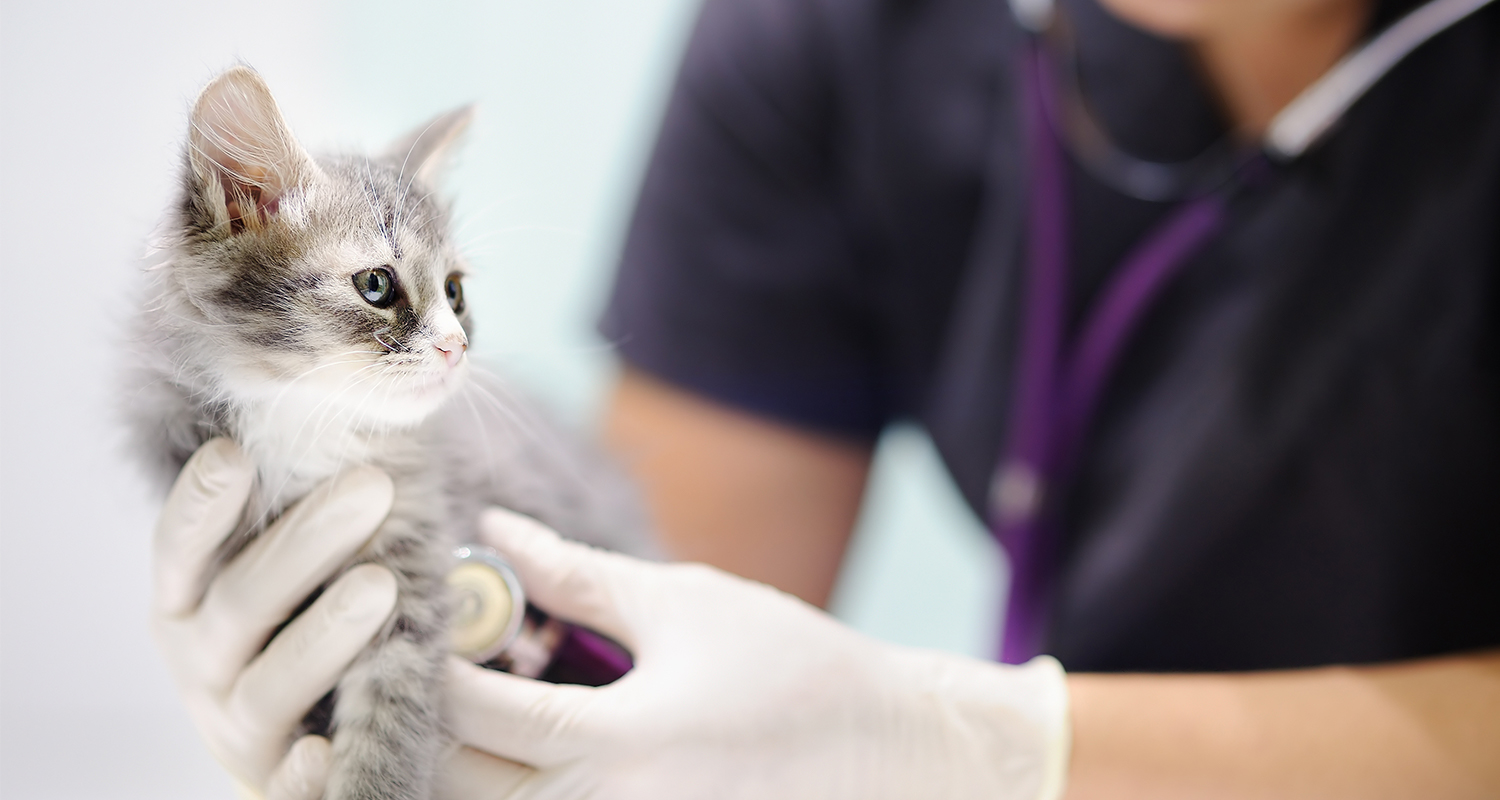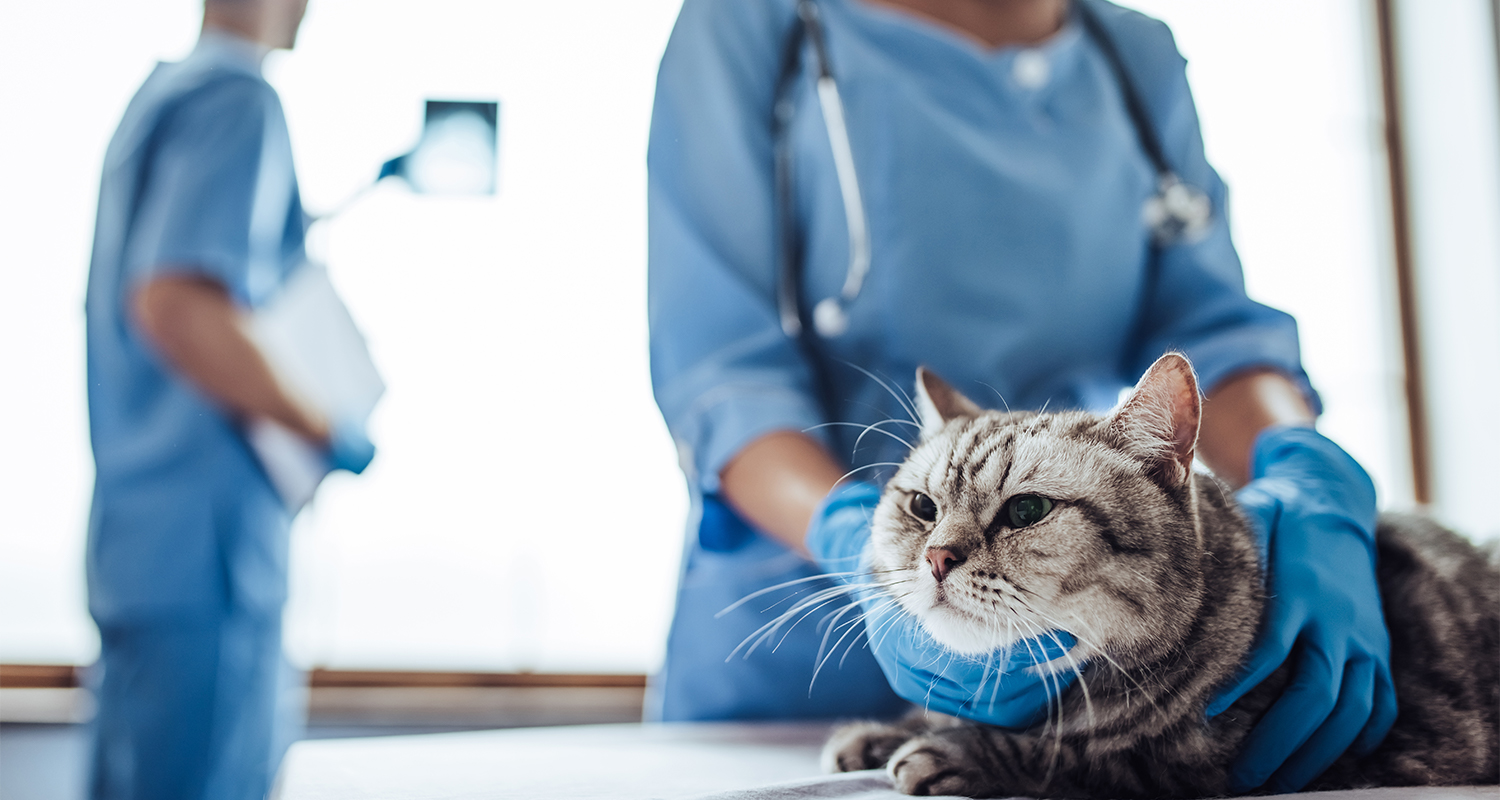
How To Diagnose Feline Asthma
This article is part of our Cat Asthma series.
Download the Full Guide to Cat Asthma
Like asthma in humans, cat asthma is chronic inflammation of the airways that can cause asthma attacks—often triggered by stress, allergens, or other environmental factors.
In cats, asthma attacks can be easily mistaken for passing a hairball or another condition. Since these attacks can be life-threatening, it’s important to take your cat to the vet right away for a diagnosis and proper treatment.
Diagnosing Feline Asthma: What To Expect At The Vet
There isn’t a specific test that proves your cat has feline asthma—a diagnosis is only made once other conditions are ruled out. Some conditions that can have similar signs and symptoms of asthma include pneumonia, parasites, foreign bodies, cardiac dysfunction, and upper respiratory infections.
There are several tests vets will use to rule out these other conditions and arrive at a feline asthma diagnosis. You can expect your vet to ask questions about your cat’s medical history, use imaging to assess your cat’s lungs and airways, and run tests on blood and urine.
1. Stabilization Of Symptoms
If your cat is in distress when you take them to the vet, the primary goal will be to stabilize their condition. Your cat may be coughing, wheezing, or breathing rapidly. Your vet will not be able to effectively assess your cat’s condition and run tests until the symptoms are under control.
Your cat may be provided an injectable steroid, such as dexamethasone, and an inhaled or injectable fast-acting bronchodilator to open the airways, such as terbutaline or albuterol/salbutamol, respectively.1
2. Medical History Evaluation
To help give your vet an idea of your cat’s condition, they will ask a series of questions. In the case your cat is not showing symptoms when you take them to the clinic, your vet will want to know as much information as possible to properly diagnose and treat your pet.

Your vet will ask questions like:
- Is your cat an indoor or outdoor cat?
- Are there other pets in the home?
- Is your cat exposed to triggers like dust, smoke, or strong fragrances?
- Has your cat’s behaviour changed at all?
- What kinds of symptoms (e.g. coughing, vomiting, blue gums) has your cat been showing at home?
If possible, try to take a video of your cat coughing, wheezing, or breathing heavily to show your vet.
3. Physical Examination
Once your vet has a thorough medical history of your cat, they will perform a physical exam. This exam will likely include listening to your cat’s chest with a stethoscope, measuring your cat’s weight, and feeling the neck, thorax, and abdomen for any abnormalities.
4. Conduction Of Imaging Tests
Cat Asthma Chest X-Rays
When diagnosing feline asthma, radiographs (x-rays) are useful for seeing potential issues in your cat’s airways and lungs. Your vet will look for a branching bronchial pattern and signs of air trapping and hyperinflation present on the radiograph, both signs that the airways have constricted so much that air cannot be exhaled.2
Your vet will also look for doughnuts and tramlines—the names given to thickened airway walls due to inflammation and mucous build-up common in respiratory diseases, including cat asthma. When viewing the airway end-on, the thickening is referred to as doughnuts, and when viewing the airway from the side, the thickening is referred to as tramlines.
Although they can be useful for pinpointing issues, x-rays are not always effective when diagnosing cat asthma—up to 23% of cats with asthma show normal x-rays.3

Cat Asthma Computed Tomography
Computed tomography (CT) is occasionally used to diagnose feline asthma and determine if there are other airway diseases present, although it is still relatively experimental. This method uses x-rays to create a 3-D image of the thorax.
Cat Asthma Bronchoscopy
A bronchoscopy is a procedure where a camera on a flexible tube is inserted through the mouth and into the airways after sedation. This technique can be used to get a clear picture of the airways, and if indicated, to collect a sample of tissue from the walls of the airways.
Cats with asthma often have changes in appearance of the lining of the airways due to inflammation. However, it is important to note that other respiratory conditions can show similar characteristics.5
Bronchoalveolar Lavage
Bronchoalveolar lavage (BAL) is similar to bronchoscopy, but targets the deeper parts of the lungs and uses a saline wash (salt water) to collect fluid samples from the small airways for analysis.6
5. Conduction Of Further Testing
Blood Tests
Your vet will likely order blood tests to gather a complete blood count and evaluate the serum blood chemistries to assess your cat’s general health. If your cat is persistently coughing, your vet will conduct a heartworm blood test.7
Urine Samples/Fecal Examination
Your vet may ask you to collect urine and stool samples at home. A urinalysis will help assess your cat’s overall health and any potential issues. A stool sample is taken to look for the presence of parasites such as lungworms.8
Post-Diagnosis Treatment
Once your cat receives a cat asthma diagnosis, your vet will prescribe treatment options to help manage your cat’s condition. The medications your vet may prescribe include corticosteroids and bronchodilators. While the class of medications may be similar to what was used during diagnosis, the delivery format for long term disease management will often change to an inhaler for ease of administration and improved quality of life.
Corticosteroids
Corticosteroids are medications that help reduce inflammation in the airways. These medications are used for daily disease management and need to be used regularly to be effective.
Unfortunately, oral and injected forms of corticosteroid medications can cause serious side effects and are not recommended for regular use. On the other hand, inhaled corticosteroids deliver much smaller amounts of medication directly to the lungs. Unlike oral and injected forms, inhaled medications do not need to be processed by the body, meaning there are much fewer physical and behavioural side effects to be concerned about.
Bronchodilators
Bronchodilators are medications that open the airways when your cat is suffering an asthma attack. These medications are also available in oral, injected, and inhaled forms. Inhaled bronchodilator medication is preferred as it can achieve rapid relief by targeting the airways directly.
Inhaled medications can be administered with the use of a spacer device such as the AeroKat* Chamber. This device captures and holds medication so the cat can breathe in the full dose.
Environmental Modifications
Your vet will also advise you to reduce your cat’s exposure to common triggers and allergens. They may suggest the following in addition to medication management:
- Switching to a low-dust cat litter
- Making sure your cat is in a well-ventilated environment
- Limiting your cat’s exposure to smoke, strongly scented products, and harsh chemicals
Cat asthma is a lifelong condition and requires routine treatment to keep symptoms under control. However, with proper management, your cat can live a normal, active life. Learn more about the different types of treatments available for cat asthma.
Take Your Cat To The Vet If You Suspect Asthma
If you think your cat may be suffering from asthma, don’t wait until the condition worsens to seek treatment. Coughing, wheezing, and shortness of breath could be signs of asthma or another serious health issue and warrants immediate treatment—always err on the side of caution and take them to the vet
Other Helpful Resources:
- Cat Asthma: What It Is, Symptoms To Look For, And How To Treat It
- Treating Asthma In Cats: Medications, Efficacy, & Side Effects
- How To Use A Cat Inhaler To Treat Feline Asthma
Take the Feline Asthma Assessment to see if your cat could have asthma.
1 REF: Managing Feline Asthma & Canine Bronchitis. Clinician’s Brief (ahead of print - website to be available)
2https://files.brief.vet/migration/article/41751/co_update-diagnosis--tr…
3https://files.brief.vet/migration/article/41751/co_update-diagnosis--tr…
4https://www.vet.cornell.edu/departments-centers-and-institutes/cornell-…
5https://pdfs.semanticscholar.org/a0d6/3fcf55ecde239c04ec9459c15f5bb50b7…
6https://vcahospitals.com/know-your-pet/inhalant-treatment-for-feline-as…
7https://pdfs.semanticscholar.org/a0d6/3fcf55ecde239c04ec9459c15f5bb50b7…
8https://vcahospitals.com/know-your-pet/inhalant-treatment-for-feline-as…
